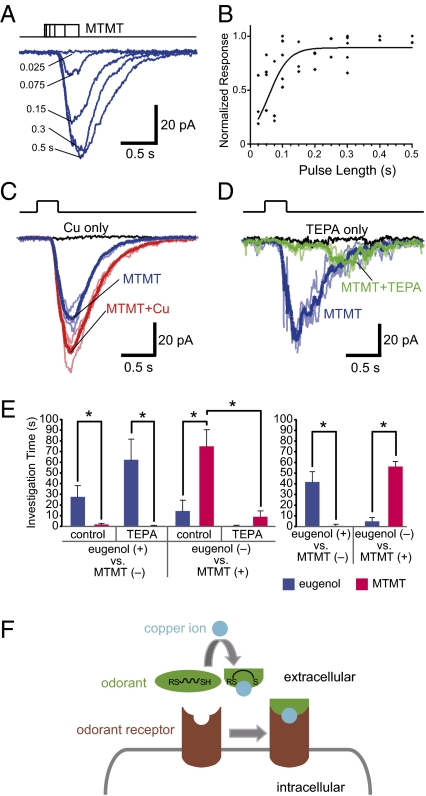Fig. 4.
Physiological relevance of copper in the detection of MTMT. (A–D) MTMT responsive OSNs are present in the SO. (A) In a single non-SR1 cell, inward currents were elicited by MTMT pulses with varying length from 0.025 to 0.5 s. (B) The dose–response curve was fitted by grouping the data from six cells tested by MTMT pulses with different lengths. For each cell, the peak current induced by a pulse was normalized to the maximum response in that cell. (C) In some cells, the MTMT (10 μM) response was facilitated by adding 30 μM Cu2+. (D) In some cells, the MTMT response (10 μM) was reduced by adding 30 μM TEPA. In C and D, the thick trace was averaged from three trials under that condition (thin lines). All recordings were performed under voltage clamp mode with a holding potential of −60 mV. (E) Mice were trained to associate either eugenol or MTMT with sugar reward. On the test day, mice were injected with dH2O or TEPA and then tested for the ability to discriminate the two odors. Left: TEPA injection specifically abolishes olfactory detection of MTMT. Right: Recovery of olfactory discrimination ability for eugenol and MTMT 2 d after TEPA injection. Two days after the initial testing, mice were retested for the recovery of the ability to discriminate the two odors. The y axis represents time spent investigating each odorant during the 9-min test period, shown as mean ± SEM. Paired t test was used to compare the investigation times between groups. *P < 0.05 (n = 4). (F) A model for OR activation involving copper ion as a cofactor with the copper ion binding to the ligand for subsequent binding of the copper ion–odor complex to the OR.

